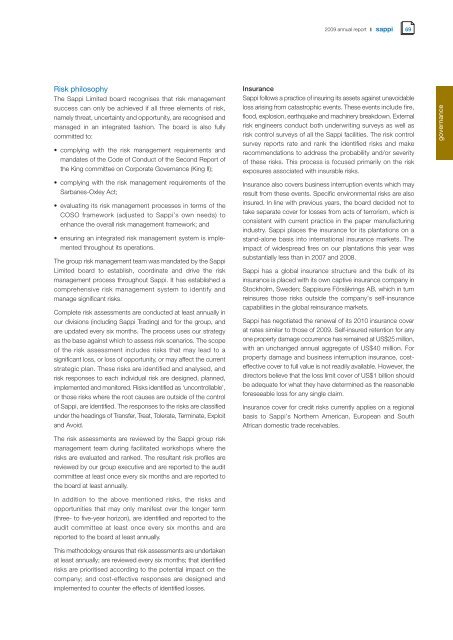Our performance in 2009 - Sappi
Our performance in 2009 - Sappi
Our performance in 2009 - Sappi
Create successful ePaper yourself
Turn your PDF publications into a flip-book with our unique Google optimized e-Paper software.
Risk philosophy<br />
The <strong>Sappi</strong> Limited board recognises that risk management<br />
success can only be achieved if all three elements of risk,<br />
namely threat, uncerta<strong>in</strong>ty and opportunity, are recognised and<br />
managed <strong>in</strong> an <strong>in</strong>tegrated fashion. The board is also fully<br />
committed to:<br />
comply<strong>in</strong>g with the risk management requirements and<br />
mandates of the Code of Conduct of the Second Report of<br />
the K<strong>in</strong>g committee on Corporate Governance (K<strong>in</strong>g II);<br />
comply<strong>in</strong>g with the risk management requirements of the<br />
Sarbanes-Oxley Act;<br />
evaluat<strong>in</strong>g its risk management processes <strong>in</strong> terms of the<br />
COSO framework (adjusted to <strong>Sappi</strong>’s own needs) to<br />
enhance the overall risk management framework; and<br />
ensur<strong>in</strong>g an <strong>in</strong>tegrated risk management system is implemented<br />
throughout its operations.<br />
The group risk management team was mandated by the <strong>Sappi</strong><br />
Limited board to establish, coord<strong>in</strong>ate and drive the risk<br />
management process throughout <strong>Sappi</strong>. It has established a<br />
comprehensive risk management system to identify and<br />
manage significant risks.<br />
Complete risk assessments are conducted at least annually <strong>in</strong><br />
our divisions (<strong>in</strong>clud<strong>in</strong>g <strong>Sappi</strong> Trad<strong>in</strong>g) and for the group, and<br />
are updated every six months. The process uses our strategy<br />
as the base aga<strong>in</strong>st which to assess risk scenarios. The scope<br />
of the risk assessment <strong>in</strong>cludes risks that may lead to a<br />
significant loss, or loss of opportunity, or may affect the current<br />
strategic plan. These risks are identified and analysed, and<br />
risk responses to each <strong>in</strong>dividual risk are designed, planned,<br />
implemented and monitored. Risks identified as ‘uncontrollable’,<br />
or those risks where the root causes are outside of the control<br />
of <strong>Sappi</strong>, are identified. The responses to the risks are classified<br />
under the head<strong>in</strong>gs of Transfer, Treat, Tolerate, Term<strong>in</strong>ate, Exploit<br />
and Avoid.<br />
The risk assessments are reviewed by the <strong>Sappi</strong> group risk<br />
management team dur<strong>in</strong>g facilitated workshops where the<br />
risks are evaluated and ranked. The resultant risk profiles are<br />
reviewed by our group executive and are reported to the audit<br />
committee at least once every six months and are reported to<br />
the board at least annually.<br />
In addition to the above mentioned risks, the risks and<br />
opportunities that may only manifest over the longer term<br />
(three- to five-year horizon), are identified and reported to the<br />
audit committee at least once every six months and are<br />
reported to the board at least annually.<br />
This methodology ensures that risk assessments are undertaken<br />
at least annually; are reviewed every six months; that identified<br />
risks are prioritised accord<strong>in</strong>g to the potential impact on the<br />
company; and cost-effective responses are designed and<br />
implemented to counter the effects of identified losses.<br />
<strong>2009</strong> annual report 69<br />
Insurance<br />
<strong>Sappi</strong> follows a practice of <strong>in</strong>sur<strong>in</strong>g its assets aga<strong>in</strong>st unavoidable<br />
loss aris<strong>in</strong>g from catastrophic events. These events <strong>in</strong>clude fire,<br />
flood, explosion, earthquake and mach<strong>in</strong>ery breakdown. External<br />
risk eng<strong>in</strong>eers conduct both underwrit<strong>in</strong>g surveys as well as<br />
risk control surveys of all the <strong>Sappi</strong> facilities. The risk control<br />
survey reports rate and rank the identified risks and make<br />
recommendations to address the probability and/or severity<br />
of these risks. This process is focused primarily on the risk<br />
exposures associated with <strong>in</strong>surable risks.<br />
Insurance also covers bus<strong>in</strong>ess <strong>in</strong>terruption events which may<br />
result from these events. Specific environmental risks are also<br />
<strong>in</strong>sured. In l<strong>in</strong>e with previous years, the board decided not to<br />
take separate cover for losses from acts of terrorism, which is<br />
consistent with current practice <strong>in</strong> the paper manufactur<strong>in</strong>g<br />
<strong>in</strong>dustry. <strong>Sappi</strong> places the <strong>in</strong>surance for its plantations on a<br />
stand-alone basis <strong>in</strong>to <strong>in</strong>ternational <strong>in</strong>surance markets. The<br />
impact of widespread fires on our plantations this year was<br />
substantially less than <strong>in</strong> 2007 and 2008.<br />
<strong>Sappi</strong> has a global <strong>in</strong>surance structure and the bulk of its<br />
<strong>in</strong>surance is placed with its own captive <strong>in</strong>surance company <strong>in</strong><br />
Stockholm, Sweden; <strong>Sappi</strong>sure Försäkr<strong>in</strong>gs AB, which <strong>in</strong> turn<br />
re<strong>in</strong>sures those risks outside the company’s self-<strong>in</strong>surance<br />
capabilities <strong>in</strong> the global re<strong>in</strong>surance markets.<br />
<strong>Sappi</strong> has negotiated the renewal of its 2010 <strong>in</strong>surance cover<br />
at rates similar to those of <strong>2009</strong>. Self-<strong>in</strong>sured retention for any<br />
one property damage occurrence has rema<strong>in</strong>ed at US$25 million,<br />
with an unchanged annual aggregate of US$40 million. For<br />
property damage and bus<strong>in</strong>ess <strong>in</strong>terruption <strong>in</strong>surance, costeffective<br />
cover to full value is not readily available. However, the<br />
directors believe that the loss limit cover of US$1 billion should<br />
be adequate for what they have determ<strong>in</strong>ed as the reasonable<br />
foreseeable loss for any s<strong>in</strong>gle claim.<br />
Insurance cover for credit risks currently applies on a regional<br />
basis to <strong>Sappi</strong>’s Northern American, European and South<br />
African domestic trade receivables.<br />
governance
















